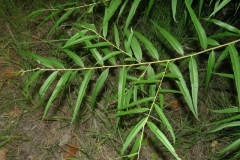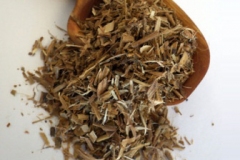
Branches
Shoots and larger branches are pointed upright. The smaller branches are drooping and sagging. Branches are brittle and can break easily. If placed in moist soils, these branches will take root. It occurs along the concave or the inner meander of streams and rivers where broken branches may drift to their new location.
Twigs are slim, flexible and rounded. They are brittle at their base. Each twig is red-brown, light orange, olive, orange-green, golden yellow, yellow green and is hairless. The young twigs are slightly hairy. Older twigs are darker and grayer. Twigs are alternate U-shaped leaf scars. Each leaf scar has 3 bundle scars and longitudinal ridge running downward.
Buds
There are no terminal buds. Lateral buds are about 1/8 inch long, conical, narrow, shiny, smooth, brown to red or yellow-brown and pointed. They are appressed and flat upon the side next to the twig and are rounded upon the opposite side. Each bud has only one cap like scale.
Leaves
Leaves are simple, alternate and deciduous. Each leaf is lanceolate and linear. They are rounded or wedged at bases and long tapered tips which are curved to one side and finely serrated margins with 15 to 30 teeth per inch. They are 1 to 8 inches long and about 1/8 to ¾ inches wide. They are hairless, shiny dark green above and lighter green below. Leaf petioles are short, glandless, hairy and short. Leaves are fast growing shoots having stipules which often encircle the shoot. Stipules are large, green, paired, ovoid or semi-cordated, persistent and dentate.
Facts About Black willow
| Name | Black willow |
|---|---|
| Scientific Name | Salix nigra |
| Native | Native to eastern North America, from New Brunswick and southern Ontario west to Minnesota, and south to northern Florida and Texas. |
| Common/English Name | Willow black American, Pussywillow, Catkin Willow |
| Name in Other Languages | English: Black willow, Swamp willow; Swedish: Svartpil; French: Saule noir; German: Schwarz-Weide, Amerikanische Schwarz-Weide; Italian: Salice nero Russian: Iva chernaia (Ива чёрная); Slovenian: Črna vrba; Spanish: Sauce negro; Swedish: Svartpil |
| Plant Growth Habit | Medium-sized deciduous tree |
| Plant Size | 10–30 m (35–100 ft) tall |
| Bark | Dark brown to blackish |
| Leaf | 5–15 centimeters (2–6 in) long, 0.5–2 centimeters (1⁄4–3⁄4 in) broad |
| Buds | 2–4 millimetres (1⁄16–3⁄16 in) long |
| Flower | Dioecious, greenish, yellow to yellow |
| Fruit shape & size | Capsule, 5 millimeters (3⁄16 in) |
| Medicinal part | The bark |
Flowers
Flowers are dioecious with both male and female flowers borne upon 1 to 3 inches long catkins. There are no calyx and corolla. Bracts are yellow, blunt tipped and hairy. Catkins are located atop the young shoots. Male flowers borne in yellow, crowded, hairy, slender and erect catkins. Female flowers are urn shaped, green and borne upon shorter catkins. They have one basal gland, stalked, basal gland and ovoid.
Fruit
Fruits are 1/8 to ¼ inch long, short stalked, light red brown to green, smooth, conic or ovoid, one celled and bivalve pods or capsules. They are arranged in 3 to 6 inch clusters. They mature in May to July and split.
Seeds
Seeds are small, fluffy and light. Seeds are densely covered with long, white, haired and basal tufts. Seeds are carried by wind or by water.
Health Benefits of Black Willow
- Treatment for acne
Salicylic acid is an ingredient used for treating acne. It is a natural exfoliator and eliminates dead cells and prevents pores from closing and causing pimples. The daily use of salicylic acid keeps skin free from excess dead cells for preventing acne breakouts. Willow bark has acids which has similar to cyclic acid and helps to exfoliate the skin and makes it blemish free.
- Wrinkles
Salicylic acid is an exfoliator that helps to smoothen skin. It minimizes the appearance of wrinkles and fine lines due to exfoliation, smoother and soften skin. Ingredients found in extract of Willow bark is similar to cyclic acid and benefits of Zinc. It sloughs off dead cells and exhibits new, soft and supple skin cells and lowers appearance of lines and wrinkles.
Uses
Willow is very similar in action to quinine; the active principle is Salicin and is believed to be far more valuable for ague and low grades of fever. These salicylic acids are found in a number of herbal remedies used throughout the world, some dating as far back as the Stone Age. We cannot trace the discovery of how the Willow first became known to the American Indians, we can only tell you that when they were in need of a fever-reducing agent Willow bark tea was given.
In 1763 the Rev. Edward Stone applied an old-fashioned theory. Three things were obvious—low, marshy regions; rheumatism; Willow trees. He tried a decoction of Willow bark on sufferers of rheumatic complaints and thus rediscovered the effectiveness of salicylic acid (Salix is Latin for Willow). It wasn’t long before experimentally inclined chemists began synthesizing this substance from common coal tar and petroleum derivatives, according to a standard recipe given in many elementary chemistry text books. Today it is known as common aspirin. The amount swallowed to date in the U.S.A. is approaching an annual 35 million lb., or five tablets a week for every man, woman and child. The contents of modern aspirin is from man’s integrity rather than from God’s goodness. Is highly recommended and largely used in the treatment of spermatorrhoea, nocturnal emissions, etc. Also relieves ovarian pain.
Dose
Combine 3 grains Willow (S. nigra) and ½ grain Capsicum (Cayenne) when there is great prostration. Add ½ grain Golden seal (Hydrastis canadensis) when the heart as well as the nervous system needs sustaining. To be given in gelatin capsule three times daily before meals. Of the infusion, 1 oz. of bark to 1 pint of boiling water, steeped 15 min., taken in wineglassful amounts three or four times daily.
Externally
A poultice made by simmering the powdered bark in cream is most effective in gangrene and indolent ulcers, etc.
Homoeopathic Clinical
Tincture of fresh bark—Diarrhoea, Emissions, Fever, Gonorrhoea, Impotence, Masturbation, Night sweat, Nymphomania, Prostatitis, Satyriasis, spermatorrhoea.
Russian Experience
There are several kinds of Willow in Russia, Eva, Salix alba, S. capra, S. fragilis and others. The Willow, especially Weeping willow, so artistically portrayed in melancholy expressions of poetry and music, is extremely popular in parks and private gardens.
Folk Medicine
No preference is shown as to the species used for medical purposes. A decoction is prepared for fevers, rheumatism, worms and to stop bleeding (Bello-Russ. Academy of Science, Minsk, 1965).
Commercially
The Willow is not capricious as to soil conditions and is used to control eroding soil, as it is fast growing (Moscow University, Moscow, 1963). The wood is used in many farm implements and household items. The bark is used in the leather tanning industry.
Medicinal uses
- The bark decoction is used for treating spastic colon, dysentery, hoarseness, fevers, bleeding, laryngitis, fainting, kidney stones, headaches and anemia.
- Bark tea is used for debility, dyspepsia, indigestion, gangrene, fevers, lumbago, intestinal ailments and ulcers.
- Use the bark externally as a wash for treating acne, psoriasis, eczema, burns, cuts and skin ulcers.
- Use the bud resin for treating sunburns, scurvy, scratches, scalds, wounds and spring tonic.
- The bark is used as a poultice on wounds, cuts, bruises, sprains and swellings.
- Use the leaves internally for treating minor feverish illnesses and colic.
Culinary uses
- Inner bark is consumed raw or cooked.
- Dry it and ground into powder and add to cereal flour for making bread.
- Young shoots are consumed raw or cooked.
References:
https://www.itis.gov/servlet/SingleRpt/SingleRpt?search_topic=TSN&search_value=22484#null
https://en.wikipedia.org/wiki/Salix_nigra
https://indiananativeplants.org/images/resources/Gordon%20Mitchell%20Articles/GM_black_willow.pdf
https://pfaf.org/user/Plant.aspx?LatinName=Salix+nigra
https://plants.usda.gov/core/profile?symbol=SANI
https://www.henriettes-herb.com/eclectic/kings/salix-nigr.html
Comments
comments





